Physical Address
304 North Cardinal St.
Dorchester Center, MA 02124
11.1
11.2
11.3
Visit Expert Consult ( expertconsult.inkling.com ) for videos on topics discussed throughout the text.
Periocular skin lesions are commonly seen in practice. It is easy to get lost in this chapter, so read this introduction carefully. It gives you an overview of the information in the whole chapter. The main goal of the evaluation of a lid lesion is to rule out malignancy. The most common skin malignancy is basal cell carcinoma. Because basal cell carcinoma causes more than 90% of skin cancers, it is essential for you to confidently diagnose it. The easy way to diagnose basal cell carcinoma is to learn the characteristics of epithelial cell malignancy:
Ulceration
Lack of tenderness
Induration
Irregular borders and asymmetric shape
Telangiectasia
Pearly borders
Loss of lid margin architecture
We talk about these features in detail, so don’t memorize them now. If these features of malignancy are present, a biopsy should be performed to rule out malignancy. If none of these characteristics of malignancy are present, it is highly unlikely that the lesion is malignant. Once you have excluded malignancy, the important part of the evaluation is over. Spend time understanding these characteristics of malignancy rather than trying to learn the names of all the benign lesions that may occur. Get a picture in your mind of what these lesions look like. Don’t lose sight of the forest while trying to learn all the trees. Eventually, you will be able to name the majority of benign lesions, as well.
The skin has two layers, the epidermis and the dermis . Basal cell and squamous cell carcinomas arise from the epidermis. The dermis contains the skin appendages , or adnexa (the added-on features). The adnexa include hair follicles, oil (sebaceous) glands, and sweat glands. The most common adnexal malignancy is sebaceous cell carcinoma. This malignancy does not have a characteristic appearance. Sometimes a yellow pigmentation of sebaceous cell carcinoma may be noted. A chronic unilateral blepharoconjunctivitis or an eyelid margin lesion extending from the posterior lamella onto the skin should suggest a possible diagnosis of sebaceous cell carcinoma.
Pigment cells are found at the base of the epidermis. Pigment cell malignancy, or melanoma , is unusual in the periocular area, but may occur. We describe the characteristics of pigmented lesions that should make you suspect melanoma.
After you are familiar with the characteristics of epithelial cell malignancies—basal cell and squamous cell carcinomas—you are not likely to miss a cutaneous malignancy. Although any adnexal malignancy (almost always sebaceous cell carcinoma) is rare, you should keep the diagnosis in mind. All the other lesions are benign. Eventually, you can recognize the names of all the benign epithelial, adnexal, and melanocytic skin lesions (known as Aunt Minnies).
Let’s talk about the Aunt Minnies. How do you recognize your aunts and uncles at a family reunion? How do you tell your Aunt Minnie from your Aunt Blanche from your Aunt Muriel? They all look different and you have seen them many times before. We take this daily form of pattern recognition for granted. It is no different for lid lesions. After you see a lesion and learn its name, you will eventually be able to recognize it again. We discuss this concept further later in this chapter.
The last section of the chapter deals with biopsy techniques, including both incisional biopsy (removing a portion of a tumor) and excisional biopsy (removing an entire tumor). Three important techniques are the shave biopsy, punch biopsy, and cyst marsupialization. These techniques are discussed in detail.
The eyelid skin is the thinnest skin in the body. This skin contains two layers:
Epidermis
Dermis
The epidermis is the continually dividing superficial layer of the skin that covers the body. The dermis is the deep layer of the skin. Other than in the eyelid, there is a layer of subcutaneous fat deep to the dermis ( Figure 11.1 ). The eyelid skin is tightly bound to the underlying orbicularis muscle.
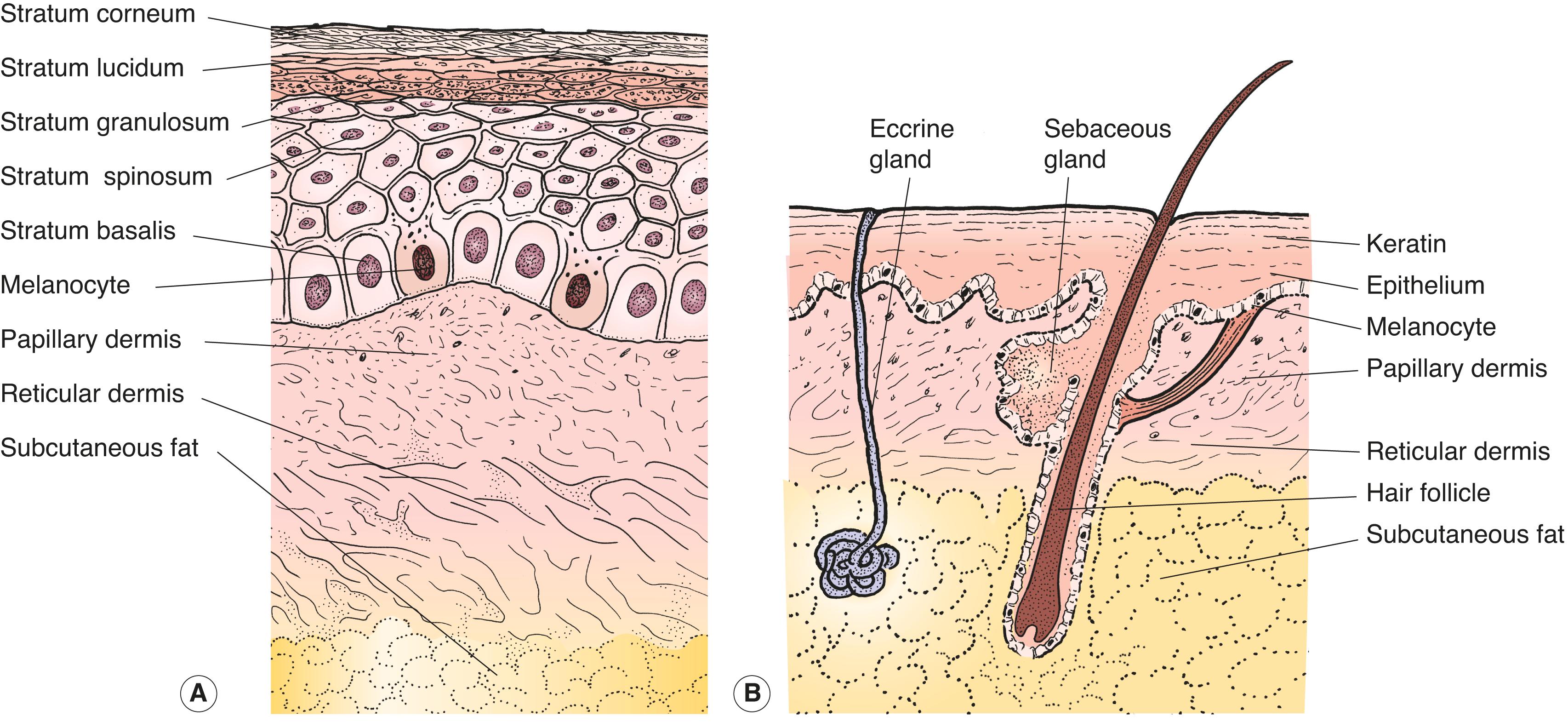
Cells destined to become the surface of the skin start as undifferentiated basal cells along the junction of the epidermis and dermis. As these epidermal cells differentiate and move toward the skin surface, they lose their nuclei, flatten, and become keratinized. The most common skin malignancy, basal cell carcinoma, arises from these undifferentiated cells in the basal layer. Because these cells are not producing keratin, basal cell carcinomas do not have excessive keratin production, or hyperkeratosis, as part of their clinical picture. In contrast, squamous cell carcinoma arises from more superficial epidermal skin cells, known as squamous cells, which produce keratin. Consequently, squamous cell carcinoma is associated with hyperkeratosis.
The dermis contains the skin appendages or adnexa (see Figure 11.1 ). The adnexa are the specialized tissues added on to the skin, including:
Sebaceous glands
Sweat glands
Hair
Each adnexal tissue contains specialized cells that may create either solid or cystic cell proliferations. Common tumors arising from the adnexa include chalazia and various cysts. Chalazia arise from the specialized sebaceous glands of the tarsal plate, the meibomian glands. The most common cyst in the periocular area, the apocrine hidrocystoma, arises from the apocrine sweat glands along the lid margin. We talk about this later. For now, just remember that there can be solid and cystic tumors of each adnexal tissue.
The dermis also contains a number of other tissues, including vascular, fibrous, and neural elements. Each of these tissues may give rise to tumors that are rarely seen in the eyelids. You are not likely to see many of these lesions, so they are not covered in this text ( Box 11.1 ).
Meibomian glands of the tarsal plate
Zeis glands associated with the eyelash follicle
Tiny sebaceous glands associated with vellus hairs (thin hairs covering the skin)
Sebaceous glands associated with the eyebrow hairs
Sebaceous glands in the caruncle
Eccrine glands (present over the entire surface of the eyelid)
Apocrine glands (the glands of Moll associated with eyelash follicles)
Eyelashes
Vellus hairs of the skin
Eyebrow hairs
This is the most important section of this chapter. Remember that the main goal of evaluating a lid lesion is to rule out malignancy. The most common skin malignancy is basal cell carcinoma, which arises from the epidermis. Basal cell carcinoma represents more than 90% of lid malignancies. If you can recognize basal cell carcinoma, you can recognize the majority of skin cancers affecting the eyelids. Review the characteristics of skin malignancy listed in Box 11.2 . If you remember these characteristics, you will have little difficulty in diagnosing cutaneous malignancies.
Ulceration: Malignant lesions tend to ulcerate; benign lesions don’t ulcerate.
Lack of tenderness: Malignant lesions are not painful or tender to touch.
Induration: Malignant lesions tend to be firm.
Irregularity: Malignant lesions have irregular borders and asymmetric shapes.
Loss of lid margin architecture: Malignancies tend to destroy normal anatomic features.
Telangiectasia: Focal telangiectasias on the periphery of a tumor suggest malignancy.
Pearly borders: Rolled translucent margins that are whitish in appearance are characteristic of basal cell carcinoma.
Ulceration is commonly seen in malignant tumors of the epidermis. Malignant cells grow rapidly, tending to outgrow their blood supply, causing areas of central ulceration. Despite areas of ulceration, often associated with bleeding, malignant lesions do not tend to be painful, nor are they tender to touch. Think of this in terms of the bowel tumors that you saw in medical school. Despite the tumor being very large and irregular, often with areas of necrosis, the patient had no pain from the tumor itself. Pain only developed when the tumor caused another problem such as a bowel obstruction or perforation. Tumor necrosis or ulceration of normal tissues results in the common symptom of blood in the stool.
All malignancies, including skin cancers, tend to be firm or indurated, so palpate each skin lesion (remember the firm bowel tumor). Benign lesions such as cysts and other epithelial lesions feel soft, similar to the surrounding skin. Again, in medical school we learned the importance of palpation in the breast, rectal, and prostate examinations.
Malignant tumors are composed of cell populations that grow at different rates. These varying growth patterns create lesions with irregular margins and asymmetric shapes. The margins of malignant lesions tend to be scalloped. Benign lesions tend to have smooth borders. Irregular borders make the shape of the lesion asymmetric so that it is not easy to imagine folding the lesion in half on itself. Look at any skin markings on your own body. Likely they are round and symmetric.
Pearly borders and telangiectasias are pathognomonic for basal cell carcinoma. Heaped-up edges often surround an area of central ulceration. With the slit beam focused on the edge of these lesions, there appears to be a translucency to the lesion (pearly borders). Likely, this appearance arises from the proliferating cells in the basal layer of the epidermis showing through the more superficial layers of the epidermis. Telangiectasias are the dilated and irregular vessels accompanying the pearly margins of the basal cell carcinoma. Review the photographs of typical basal cell carcinomas and make sure in your mind that you recognize all the features of epithelial cell malignancy ( Figure 11.2 ).
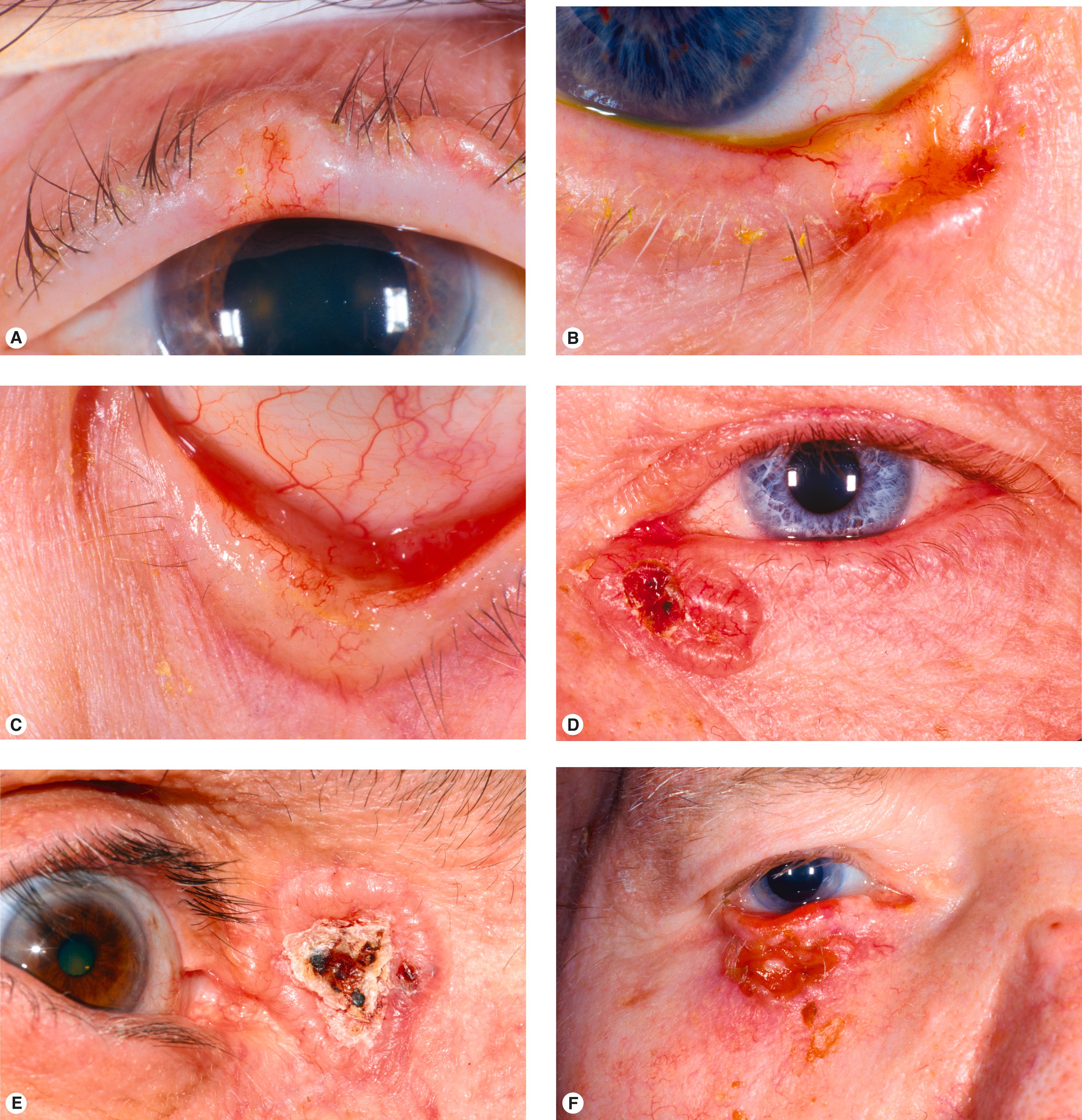
All the characteristics of malignancy are not always seen in each tumor. When one or more characteristics of malignancy exist, consider a biopsy. Look at the photos in Figure 11.2 and see how many of the features of malignancy are likely present in each example. Study these pictures carefully so you won’t miss a basal cell carcinoma. Hone your diagnostic skills and identify the subtype. Keep in mind that morpheaform lesions are not always so obvious. If you see an area of “inflammation” that does not improve with time or treatment, consider a biopsy. (You see an example in the dermatitis section in this chapter). Until you get experience, you might want to refer the patients with morpheaform lesions (see Figure 11.2I and J ). Excision is surprisingly large.
A skin malignancy may destroy the normal architecture of the lid margin. Often the tumor outgrows its blood supply, leading to ulceration and subsequent destruction of surrounding tissue. This characteristic destruction of tissues does not occur with benign lesions. Suspect malignancy when an area of lash loss or lid margin destruction is present. Remember, the goal is to diagnose malignancy. When your diagnostic skills become more sophisticated, you may be able to tell the type of skin cancer based on the location and how the lesion affects the lid margin. Study the skin carefully during the slit lamp examination. Use the slit lamp as the equivalent of the gynecologist’s colposcope used to diagnose potential malignancies of the cervix. Remember that squamous cell carcinoma tends to be the most superficial of skin cancers. These tumors may present with only scaling of the superficial epidermis in the early phases. Basal cell carcinoma begins a little deeper with rolled edges at the periphery pulling normal skin into the lesion. You do not see keratinization on the examination. Because basal cell and squamous cell carcinomas are epithelial lesions, they affect the anterior lamella initially. Sebaceous cell carcinoma affects the posterior lamella first in most patients. Look at the area of distortion or destruction of the lid margin for these clues to the type of malignancy. Don’t lose sight of the goal, which is learning to differentiate malignant from benign lesions first.
Basal cell carcinoma, like squamous cell carcinoma, is related to ultraviolet or actinic damage. Consequently, basal cell carcinoma is most common in fair-skinned patients whose skin tends to burn rather than tan in the sun. The lower lid and medial canthus are the most commonly affected locations, probably related to getting more sun exposure than the upper lid. The hallmarks of basal cell carcinoma are pearly borders with telangiectasia. Central ulceration is common. The lesions are not painful and not tender to touch. The border and contour of the lesion are generally irregular. Destruction of normal lid architecture occurs when the lesion involves the lid margin. Lashes are often lost. Hyperkeratosis is not a common finding associated with basal cell carcinoma, because these tumors arise from cells in the basal layer of the epidermis.
Basal cell carcinoma and squamous cell carcinoma may be recognized by the company that they keep. Other signs of actinic damage to the skin, especially in a patient with light skin and blue eyes, should heighten your suspicion of a skin malignancy. Look for signs of sun damage on your patient’s face to help you diagnose basal cell carcinoma ( Figure 11.3 ). Don't forget to look at the entire face. A patient presenting with ectropion, ptosis, or any other eyelid problem may have a basal cell carcinoma elsewhere on the face ( Figure 11.4 )!

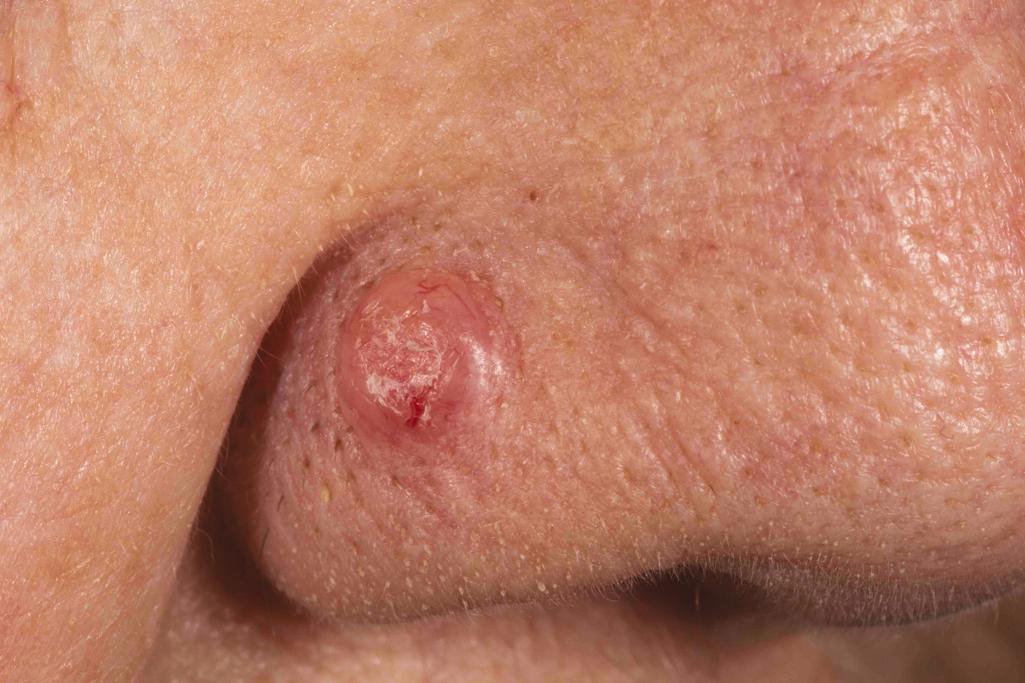
A rare genetic disorder, basal cell nevus syndrome, predisposes patients to multiple basal cell carcinomas. This autosomal dominant syndrome is also known as Gorlin syndrome. Multiple organ systems are involved aside from the skin, including the nervous, endocrine, and skeletal systems. Patients have palmar and plantar pits (tiny depressions), intracranial calcification, ovarian fibromas, jaw cysts, rib and vertebral abnormalities, and a typical facies with frontal bossing and a prominent jaw.
The genetic defect has been located on chromosome 9q involving a mutation on the PTCH ( PATCHED ) gene. Patients should be identified as early as possible and have frequent skin examinations. The lesions typically occur on the face, chest, and back. Basal cell carcinoma may occur in areas not exposed to the sun, including at the base of the skin pits on the palms and soles of the feet.
In about 10% of cases, no skin lesions develop. At the other extreme, literally thousands of basal cell carcinomas may occur. In these cases, the basal cell carcinomas can grow to be almost continuous on the facial skin. Lesions are removed as early as possible. Over time, only the worst lesions are excised because complete eradication is impossible.
This disorder is rare, but you should consider it in any young patient (adolescent or young adult) with basal cell carcinoma or in patients with multiple lesions and a strong family history.
Vismodegib is a relatively new treatment for advanced basal cell carcinoma. More than 90% of basal cell carcinomas have a mutation that causes activation of the hedgehog pathway, which is crucial for embryonic development but normally has limited activity in adult tissues. Vismodegib is an oral medication that specifically blocks the hedgehog pathway, inhibiting the growth of these cancers. The effect of treatment dissipates if the medication is stopped, however. There are many side effects of the treatment that can limit its use; however, it can be an alternative to exenteration or other radical excisions ( Figure 11.5 ). Vismodegib has no effect on squamous cell carcinoma, melanoma, or sebaceous cell carcinoma.
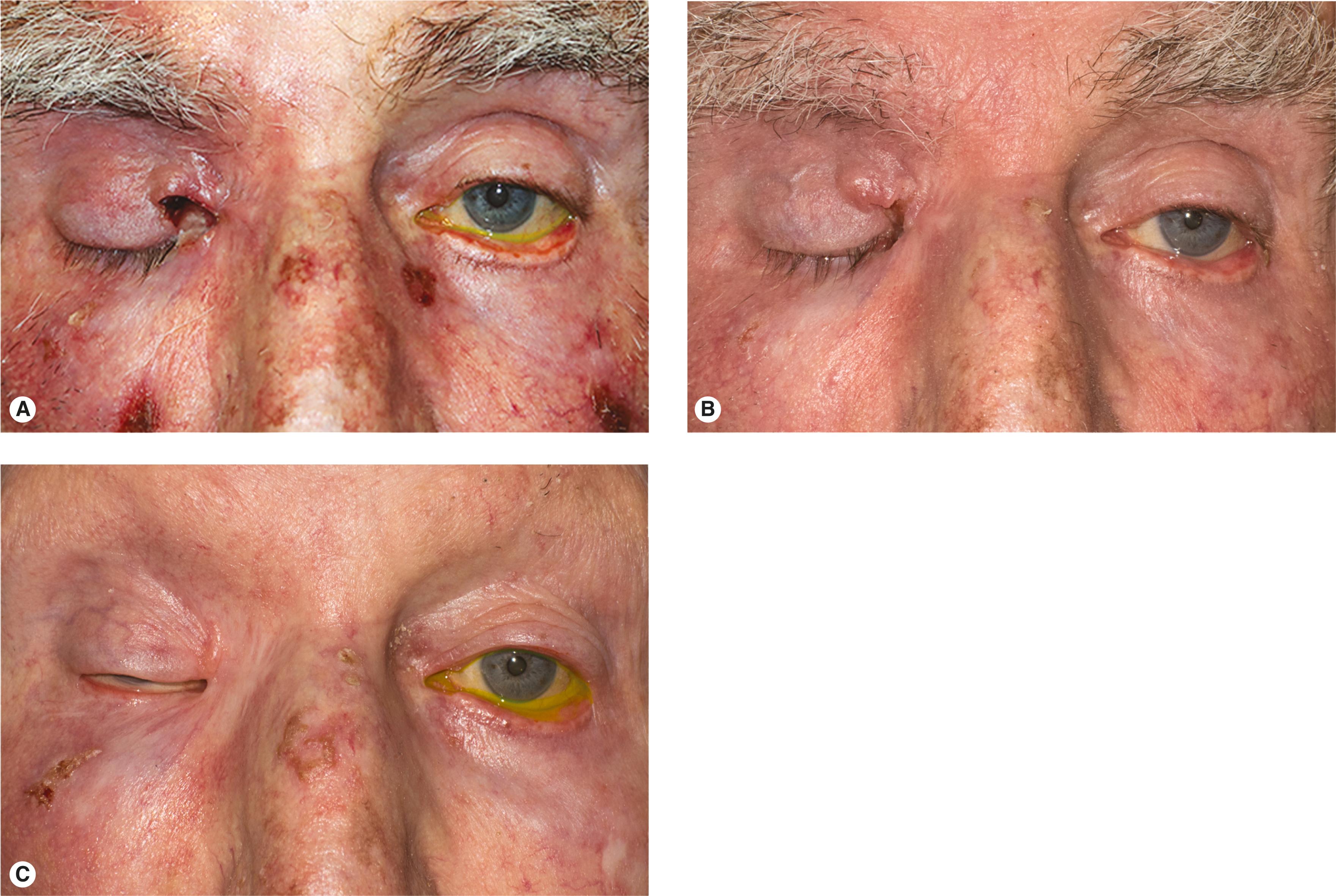
Squamous cell carcinoma may resemble basal cell carcinoma clinically. Although differentiating between these two lesions may not always be clinically possible, there should be little doubt about the presence of an epithelial malignancy based on the characteristics outlined above. Squamous cell carcinoma is much less common than basal cell carcinoma, representing less than 5% of lid tumors. If you have to guess the diagnosis, you should guess basal cell carcinoma because it is so much more common.
Squamous cell carcinoma can appear as a nodule or an indurated plaque with some hyperkeratosis ( Figure 11.6 ). Often the scaly skin falls off, strongly suggesting a squamous cell cancer or its precursor, actinic keratosis (discussed later in this chapter). Ulceration is sometimes present. Generally, the pearly margins and telangiectasias of basal cell carcinoma are not seen.

Squamous cell carcinoma is usually more aggressive than basal cell carcinoma. The margins of squamous cell carcinoma may be diffuse, resulting in a large area of subclinical tumor involvement ( Figure 11.7 ). Neurotrophic spread (along nerves) occurs in squamous cell carcinoma but is uncommon in basal cell carcinoma ( Figure 11.8 ). Squamous cell carcinoma in the periocular area with the presence of cranial nerve palsy suggests neurotrophic spread into the cavernous sinus ( Figure 11.9 ).

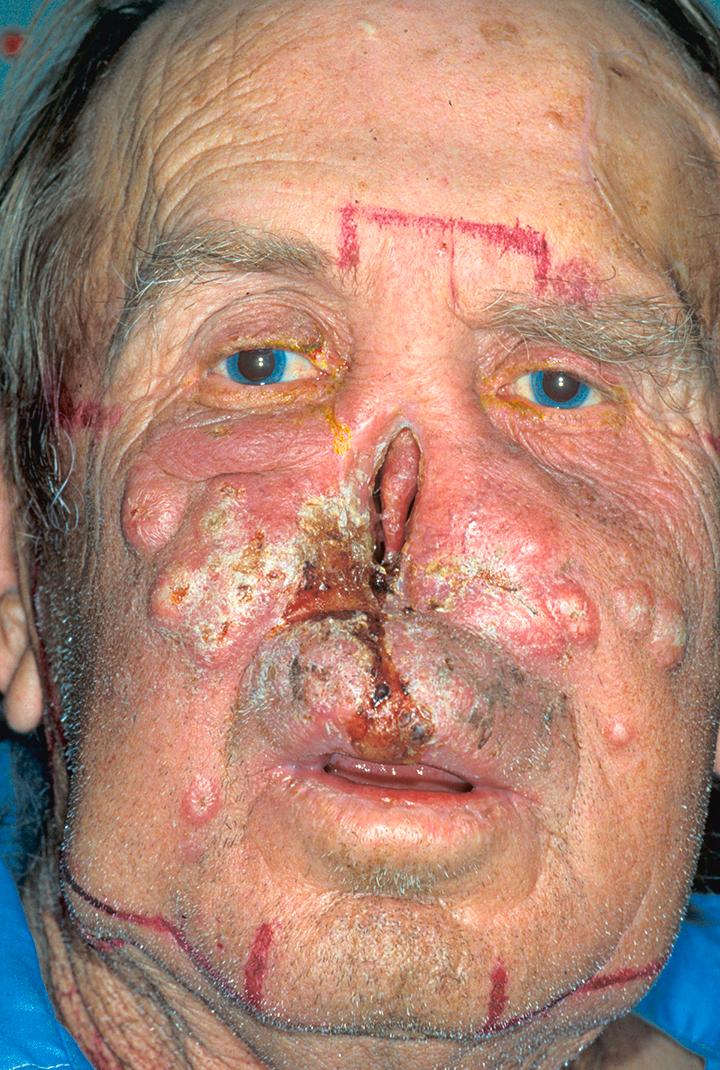
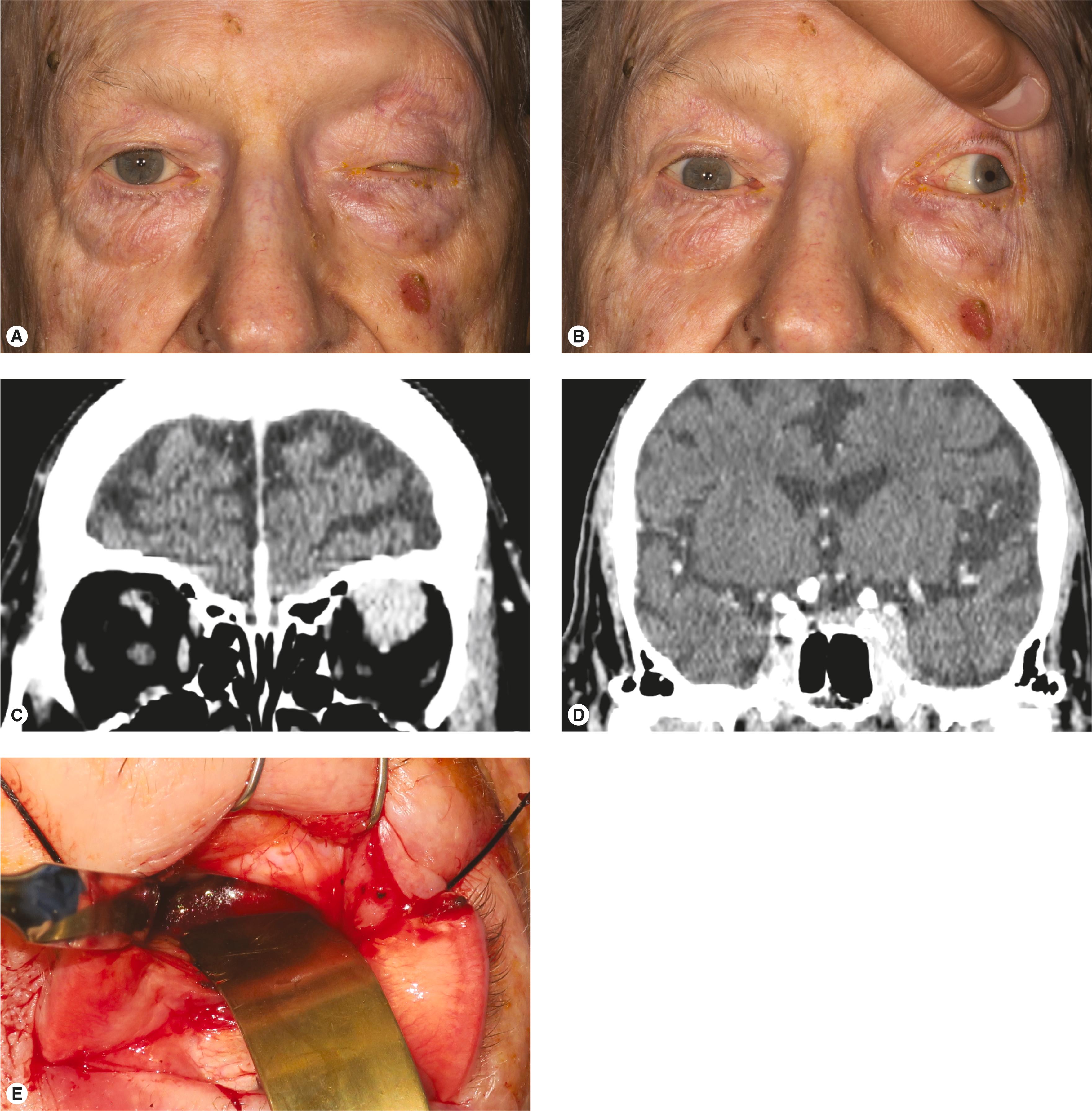
Like basal cell carcinoma, squamous cell carcinoma arises in sun-damaged skin. The features of cutaneous actinic damage, such as deep wrinkles, skin thinning, generalized telangiectasias, and mottled pigmentation, may be seen (see Figure 11.24 later in the chapter). Scaling keratotic lesions and actinic keratoses, the precursors of squamous cell carcinoma, are often present.
Keratoacanthoma is considered to be a low-grade squamous cell carcinoma. This tumor has a characteristic appearance different than that of most squamous cell carcinomas. A large lesion with a central crater filled with a keratin plug is typical. The lesion often appears in a few weeks and may spontaneously resolve. This lesion is discussed in the section Sun-Damaged Skin and Related Conditions. An illustration of this is shown in Figure 11.26 .
Malignant tumors of the dermis are very rare and are not considered here. The dermis contains the adnexa of the periocular skin. Sebaceous cell carcinoma is the most common adnexal malignancy and is discussed next.
Basal cell and squamous cell carcinomas comprise greater than 90% of the malignancies of the eyelids. Sebaceous cell carcinoma is rare, representing between 1% and 5% of eyelid cancers in the Western world. Sebaceous cell carcinoma arises within the sebaceous glands of the skin and therefore is referred to as an adnexal malignancy. As a reminder, the sebaceous glands in the periocular area are the following:
Meibomian glands located within the tarsal plates
Glands of Zeis associated with the eyelash follicles
Sebaceous glands of the periocular skin
Sebaceous glands in the caruncle
Sebaceous glands associated with eyebrow follicles
The presence of specialized sebaceous glands in the periocular area, such as the meibomian glands and glands of Zeis, makes the occurrence of sebaceous cell carcinoma in the periocular area more common than anywhere else in the body.
Sebaceous cell carcinoma has no characteristic appearance; consequently, it is known as a masquerader. You won’t see many sebaceous cell cancers. I have included some representative case photos here. Be especially suspicious if you see a unilateral blepharoconjunctivitis or a chronic or recurrent “chalazion.” In my experience, the classic recurrent chalazion is an unusual presentation. An erythematous or thickened eyelid with conjunctivitis is more common ( Figure 11.10A ). The blepharoconjunctivitis may present as a chronic condition (see Figure 11.10B ). In some patients, many medical or surgical treatments will have been tried without relief, because the diagnosis of sebaceous cell carcinoma will not have been considered.

Biopsy should be performed for chronic unilateral blepharoconjunctivitis or recurrent chalazia. In some cases, the conjunctival spread predominates, so don’t forget to evert the eyelid. In other patients, sebaceous cell carcinoma may present as a subtler thickening of the lid and lid margin (see Figure 11.10 ). You should consider the diagnosis if you see a lid margin lesion that appears to arise from or extend over the margin onto the tarsal conjunctiva (see Figure 11.10 ). The presence of any yellowish material within a malignant-appearing lesion should suggest the diagnosis of sebaceous cell carcinoma.
Again, in my experience, the notion that a sebaceous cell carcinoma can resemble a chalazion is unlikely. Figure 11.11C and D has photos of the only case of sebaceous cell carcinoma that I have seen that might be mistaken for a chalazion, and it was easily distinguished from an inflammatory lesion on clinical examination. Nevertheless, to be safe, you should send a specimen of any atypical or recurrent chalazion for pathologic examination. Obvious pagetoid spread is not common in my experience ( Figure 11.12 ). I do map biopsies on every patient to rule out conjunctival spread. You need to palpate the neck and preauricular areas for any palpable nodes. The use of the sentinel node biopsy technique for the evaluation of sebaceous cell carcinoma is controversial.
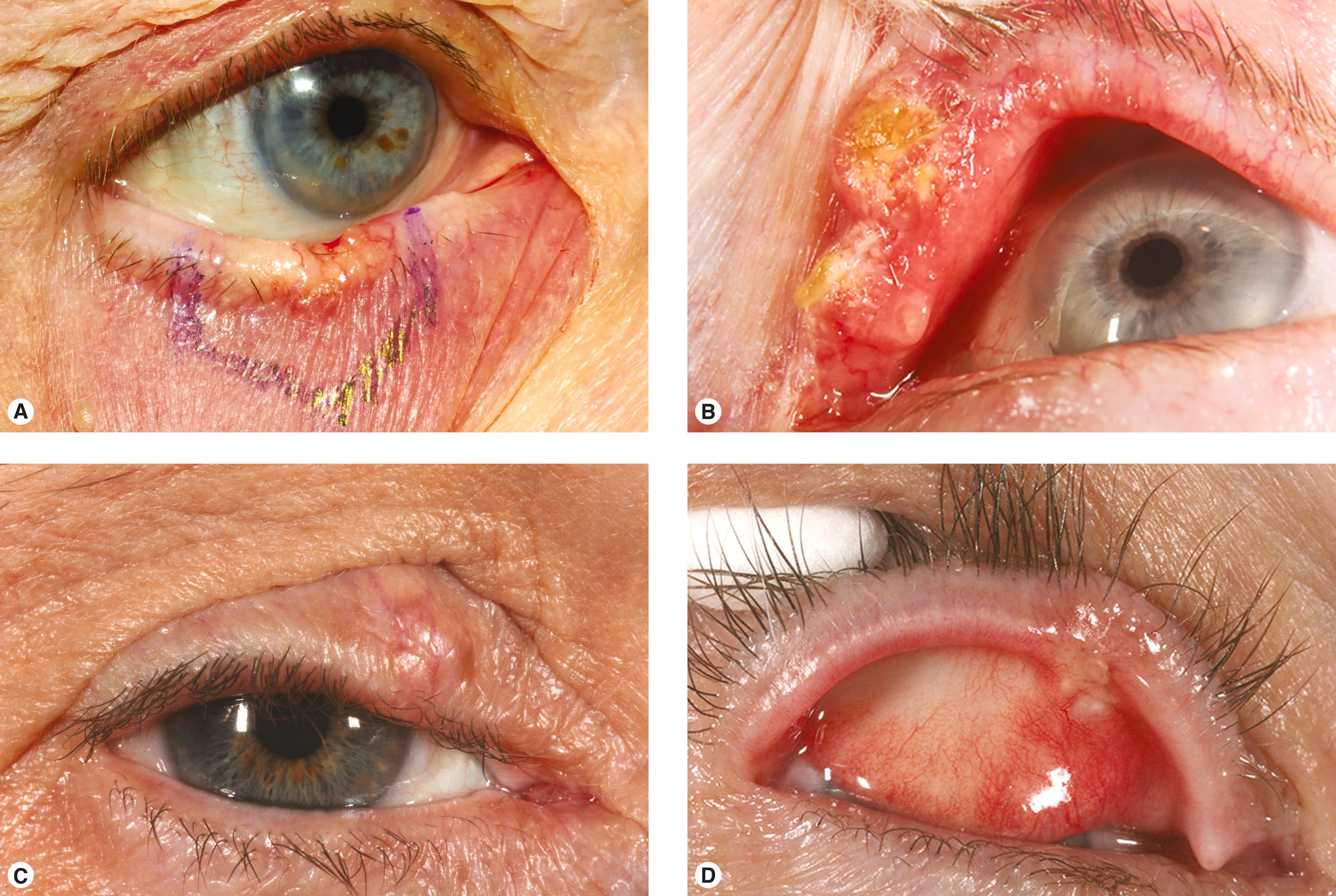
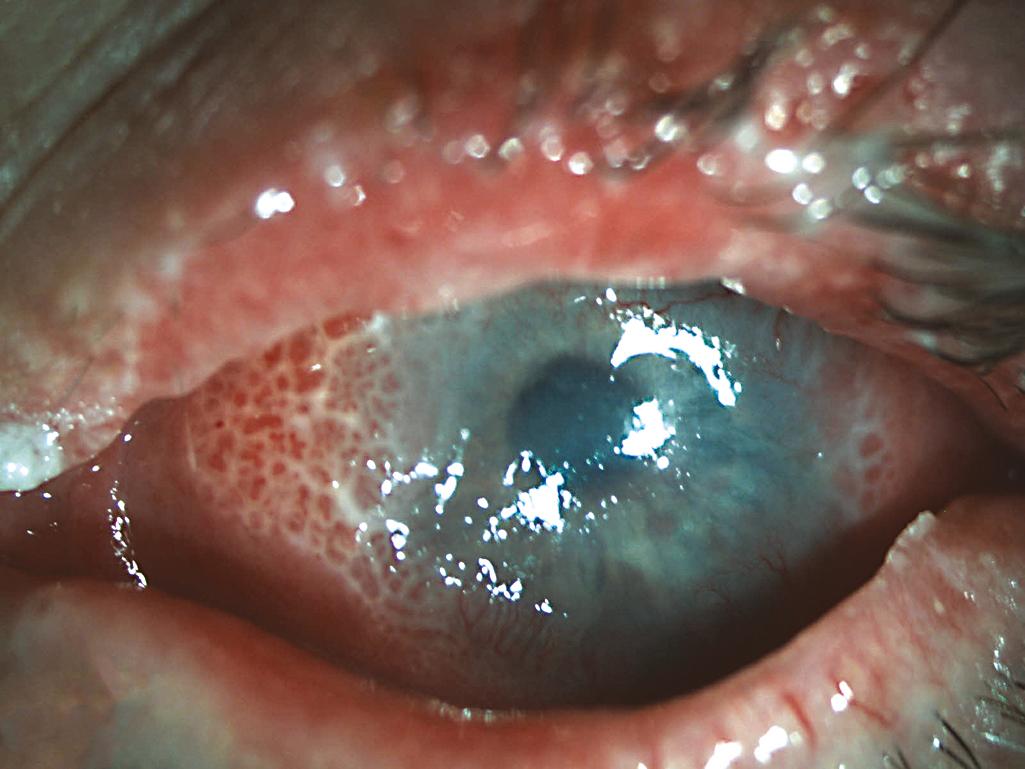
Full-thickness lid biopsy has been recommended for the diagnosis of sebaceous cell carcinoma. When there is diffuse thickening of the lid with no obvious mass, it is a good idea to do a full-thickness lid biopsy. A full-thickness specimen gives the pathologist an opportunity to see the architecture of both affected and normal lid tissues, including the conjunctival epithelium. If a large mass is present, a generous incisional biopsy of the mass itself is usually diagnostic and a full-thickness biopsy is not necessary. Small biopsies of the conjunctiva alone may be difficult to interpret. Oil red-O stain on fresh tissue was recommended for the diagnosis of sebaceous cell carcinoma in the past. Although oil red-O does stain the sebaceous material within the tumor, the histologic and cytologic features of the tumor (including the typical foamy cytoplasm seen in the dysplastic sebaceous cells) are diagnostic in most cases without this staining. The histopathologic differentiation between more poorly differentiated sebaceous cell and squamous cell carcinomas can be difficult. Immunohistochemistry can be helpful in this regard.
Remember that sebaceous cell carcinomas are rare tumors. If you suspect a sebaceous cell carcinoma, be sure to let the pathologist know. General and dermatologic pathologists see few, if any, of them. When there is any question about the diagnosis of a sebaceous cell carcinoma, consultation with an ophthalmic pathologist is appropriate. He or she is likely to have the most experience and should be able to provide the most accurate diagnosis.
The presence of a sebaceous gland should raise the possibility of Muir–Torre syndrome. Although it is a rare syndrome, the diagnosis of an eyelid sebaceous neoplasm may be its first manifestation. Muir-Torre syndrome is an autosomal dominant disease associated with multiple keratoacanthomas and visceral malignancies, especially genitourinary and gastrointestinal ones. Tumors of the breast and lung are associated, but less commonly seen. The genetic markers of the syndrome include a mutational inactivation of mismatch repair genes MSH2 and MLH1 , MSH6 and PMS2 . Immunohistochemistry of the eyelid tumor showing staining for these markers can point to a diagnosis of the syndrome. Several cases of Muir–Torre syndrome of the eyelids have been reported with both benign and malignant sebaceous carcinomas, although I have not personally seen this in 40 cases of sebaceous cell carcinoma.
Sebaceous cell carcinoma has two unusual growth characteristics that make removal difficult. The first is pagetoid spread. Intraepithelial sebaceous cell carcinoma may spread superficially over large areas of the conjunctiva. Secondly, sebaceous cell carcinoma appears to arise from multifocal noncontiguous tumor origins. These characteristics make excision of sebaceous cell carcinoma more complicated than that of the more common cutaneous malignancies. Basal cell and squamous cell carcinomas arise from a single origin and tend to spread radially. Clinical margins can be approximated and then confirmed with frozen sections. With sebaceous cell carcinoma, the true pathologic margins are often not clinically visible, even with slit lamp examination, because of the pagetoid spread. Noncontiguous tumor origins make intraoperative margin confirmation of tumor removal unreliable, because the surgical margin may be free of tumor, but another focus of tumor may be just beyond the first margin.
Most sebaceous cell carcinomas originate in the meibomian glands or Zeis glands. Beyond the two unusual growth characteristics described above, remember that sebaceous cell carcinoma can arise in the caruncle, eyelid skin, or lash follicles (from pilosebaceous glands), making the diagnosis even easier to miss.
For these reasons, the excision of sebaceous cell carcinoma is somewhat specialized. Preoperatively, map biopsies of the conjunctiva are done to determine the probable peripheral extent of any pagetoid spread. From the results of these permanent section biopsies, a surgical excision is planned. I take several biopsies from the skin surrounding the known lesion to use as scout biopsies for the excision to be performed later. I also take a few biopsies well away from the tumor to check to see if I might be missing an area of pagetoid disease. As you can imagine, this is not a foolproof technique.
At the time of excision, generous margins are taken to include the involved areas of the tarsus, lid margin, skin, and conjunctiva. There is some controversy about the usefulness of frozen sections in sebaceous cell carcinoma; pagetoid spread may be difficult to identify using this technique because of poor resolution and tissue artefacts of freezing. Permanent sections can be evaluated overnight to determine if margins are clear of tumor. This is somewhat tedious. These procedures must be started early in the week to permit further resection if necessary prior to reconstruction. There is controversy about the effectiveness of Mohs excision for sebaceous cell carcinoma because frozen-section analysis is involved in the standard Mohs surgery. A “slow Mohs” excision can be performed where the Mohs surgeon uses permanent-section analysis rather than the frozen-section technique. This is generally how my cases are currently handled.
The defect is then reconstructed using the usual techniques of repair. Because sebaceous cell carcinoma often involves the upper lid, reconstruction is often complicated. In cases where areas of pagetoid spread remain after the majority of tumor has been removed, treatment with mitomycin C can be used. These cases are at risk for severe exposure problems as a result of the often large conjunctival excision and the toxicity of the mitomycin C.
Sebaceous cell carcinoma is an uncommon tumor. It is difficult to diagnose because of its many manifestations. It is difficult to excise because of pagetoid spread and noncontiguous tumor origins. Unlike with basal cell carcinoma and squamous cell carcinoma, there is a possibility of regional lymph node metastasis ( Figure 11.13 ). In most patients, no regional disease is present at the time of diagnosis. Fortunately, local resection is usually curative. If all four lids are involved or orbital fat is invaded, orbital exenteration is required (see Figure 16.21, Figure 16.22, Figure 16.23 ). Death caused by sebaceous cell carcinoma is possible, but rare.
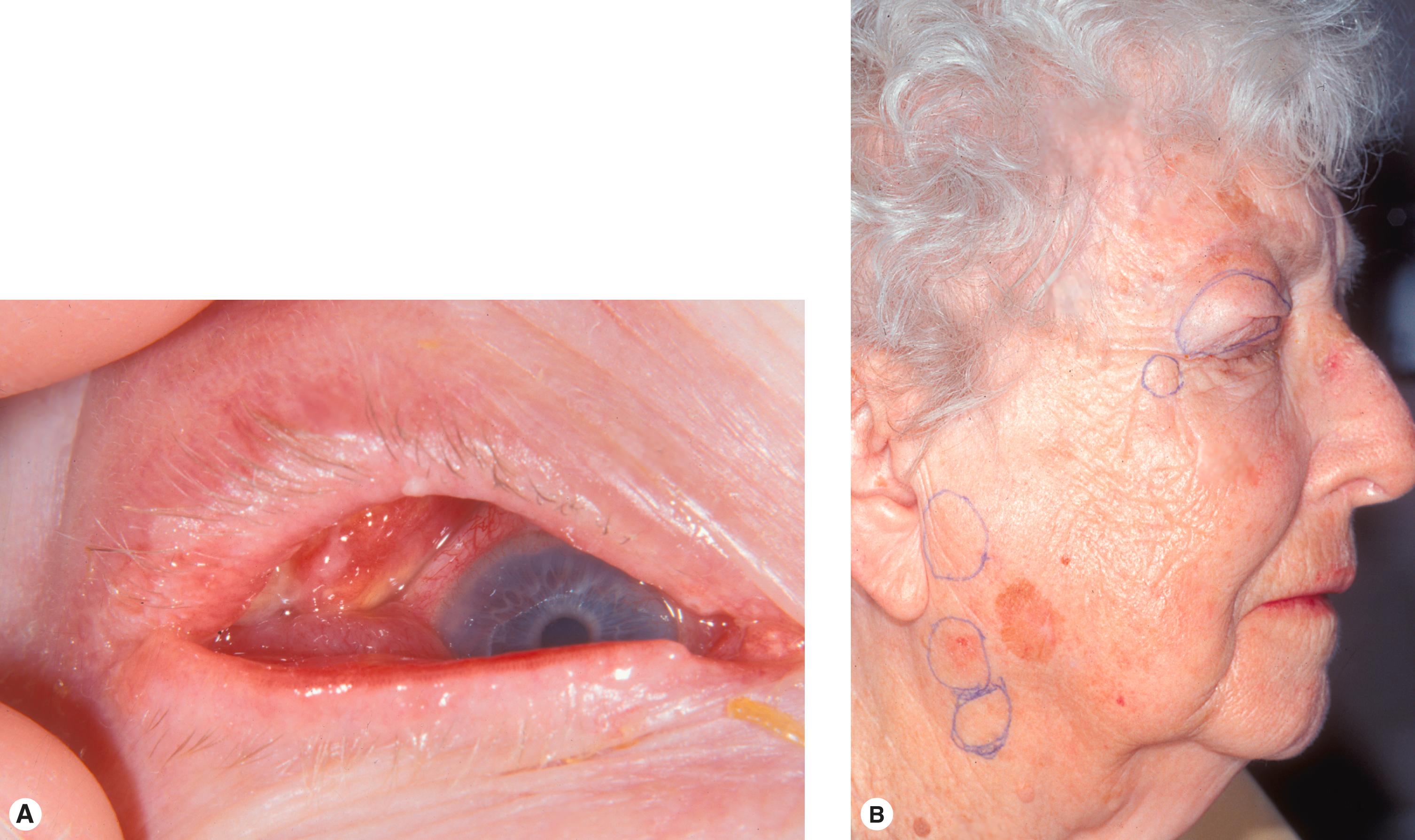
Owing to the difficulties involving adequate resection and the complexity of repair, the occasional eyelid surgeon should refer these patients for more specialized care.
Benign lesions arising in the sebaceous glands include chalazia, sebaceous hyperplasia, and sebaceous adenoma. These lesions are discussed later in the chapter.
At this point in this chapter, you should be able to diagnose the majority of the malignant lid lesions encountered in practice.
The diagnosis of most cutaneous malignancies is based on recognition of the clinical characteristics of malignancy that help you identify basal cell carcinoma and squamous cell carcinoma.
Important! What are the clinical characteristics of skin malignancy?
What growth characteristics make sebaceous cell carcinoma difficult to resect?
Chronic unilateral conjunctivitis or a presumed chalazion resistant to treatment should alert you to the possible diagnosis of sebaceous cell carcinoma.
Although eyelid melanomas are rare, we are all concerned about the possibility of a pigmented lesion being a melanoma. This section helps you to differentiate benign from malignant pigmented lesions of the skin. Let’s start with these basic concepts ( Box 11.3 ).
The majority of pigmented lesions are not melanoma.
Any type of skin lesion may be pigmented depending on the patient’s skin coloring.
Not all pigmented lesions are nevi ( Figure 11.14A ).
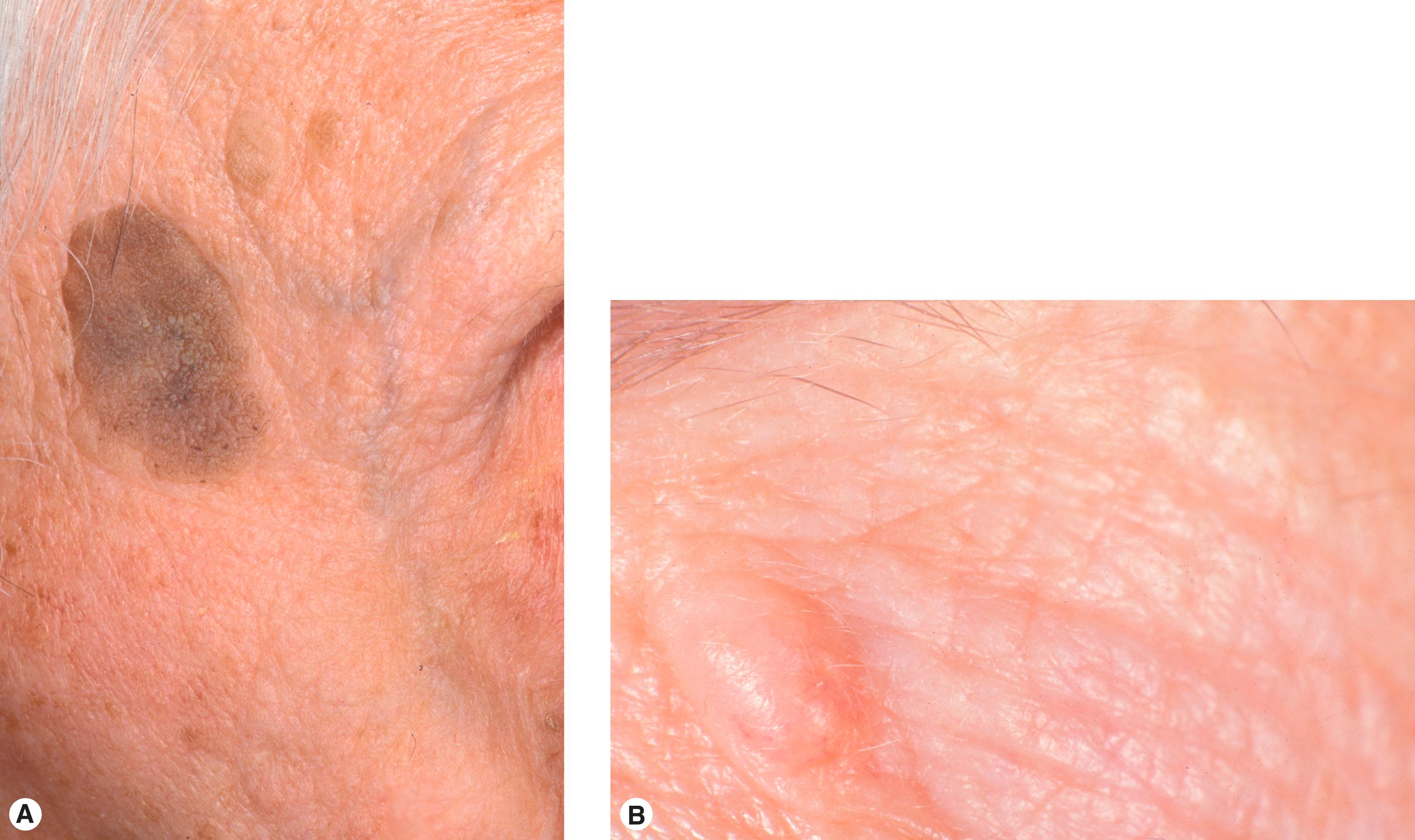
In fact, not all nevi are pigmented (we cover this later) (see Figure 11.14B ).
Most pigmented lesions are not melanomas.
Any skin lesion may be pigmented.
Not all pigmented lesions are nevi.
Not all nevi are pigmented.
Become a Clinical Tree membership for Full access and enjoy Unlimited articles
If you are a member. Log in here